China # 25 – Peking Hung Duck – September 2014
So, it was a long way to drive for dinner, like about twenty thousand miles from Portugal, or even longer from California or Belgium where our expedition truck rolled off the ship into Europe. After all that driving we could not leave Beijing without enjoying the famous Peking Duck, a dish as iconic to Beijing as sour dough bread from San Francisco.
Peking Hung Duck
According to the Beijing official web site, the dish is called Peking Duck, Beijing Duck or simply Chinese roast duck among other names. It was first served during the Yuan Dynasty (1271 to 1368), a time when the Mongol Emperors ruled China. Sounds like a dish Genghis Khan would order. Its real history goes back as far as the Southern and Northern dynasties. In 1330 a cookbook written by a royal dietary physician by the name of Hu Sihui included such elaborate preparations as roasting the duck inside the stomach of a sheep.
Green insisted on eating Peking Duck Head
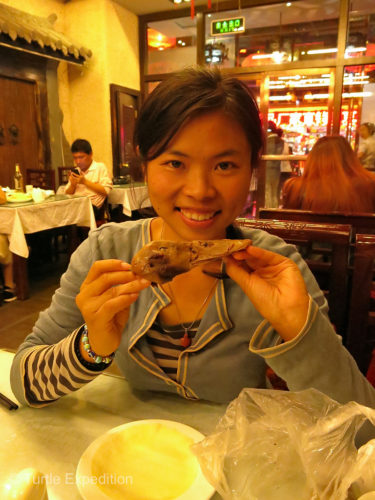
Green insisted that she get the head. Like chicken heads you might recall, she believed eating the head gives you more brain power.
Quanjude Restaurant, Beijing
Forget the sheep. The Peking duck is still a dish few chefs would dare to duplicate. First, white-feathered ducks are raised in a free-range environment for 45 days, after which they are force-fed for 15 to 20 days. Once slaughtered, plucked, gutted, washed, and boiled, air is pumped under the skin so that it separates from the fat. Next, the duck is hung to dry and coated with maltose syrup to make the skin extra crispy.
The duck is then roasted in one of two ways: by heat in a brick oven or by hanging the bird from a hook and roasting it over a fire, no doubt using a special wood. We made reservations at the highly recommended Quanjude restaurant that uses the wood fire method invented by its founder, Yang Quanren. “Solly”, “no varet palking”. According to Green, it was the original restaurant serving the delicacy. There are at least 10 other establishments in the city that feature the famous dish. We were surprised that we did not get a roasted duck on a platter. Instead, the duck is expertly carved and elegantly served, all sliced and ready to eat, along with traditional sauces and condiments. Being dark meat anyway, it was bound to be moist. It melted in our mouths and was not overly smoked. Green insisted that she’ll get the head. Like chicken heads you might recall, she believed eating the head gives you more brain power. So popular is this custom that there were plenty of extra heads to be ordered. She had two and already seemed wiser.
Very full and satisfied that we had seen what we wanted to see in Beijing, it had been a long day. The tram ride back to our parking lot and Green’s hostel was short. We would make an early start heading north to Mongolia. Shipping our truck from China was not recommended. Sitting in the customs storage lot for weeks in the salt air invited damage and theft. In any case, we had a new “bucket list”: Ride a camel in the Gobi Desert and attend the Golden Eagle hunting festival in the remote town of Olgii, with a brief stop in the capital of Ulaanbaatar to get necessary Russian visas and re-visit this rapidly changing city. We had not been there since 1996.
- Green said that the Quanjude restaurant was the best in town. The brightly lit façade made an impressive entrance for our Peking duck experience.
- First, white-feathered ducks are raised in a free-range environment for 45 days, after which they are force-fed for 15 to 20 days. Once slaughtered, plucked, gutted, washed, and boiled, air is pumped under the skin so that it separates from the fat. Next, the duck is hung to dry and coated with maltose syrup to make the skin extra crispy.
- The prepared duck is then roasted in one of two ways: by heat in a brick oven or by hanging the bird from a hook and roasting it over a fire, no doubt using a special wood.
- We were surprised that we did not get a roasted duck on a platter.
- The duck was expertly carved and elegantly served, all sliced and ready to eat, along with traditional sauces and condiments.
- This was exactly how we wanted to end our short visit to Beijing.
- Green insisted that she get the head. Like chicken heads you might recall, she believed eating the head gives you more brain power.
- So popular is this custom that there were plenty of extra heads to be ordered.
- Full and satisfied that we had seen what we wanted to see in Beijing, the tram ride back to our parking lot and Green’s hostel was short.



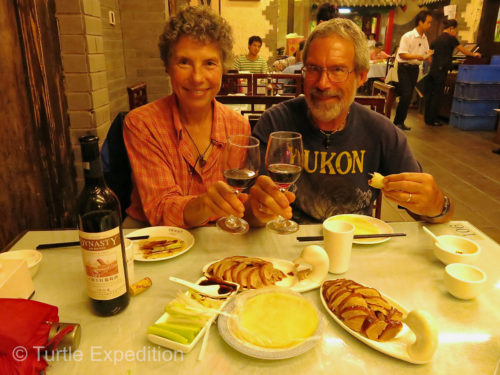
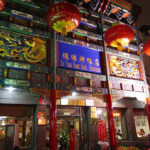
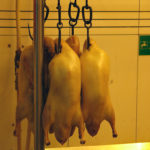
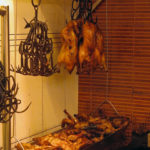
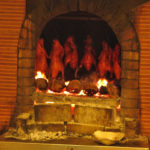
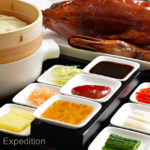
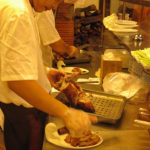
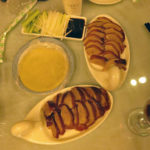
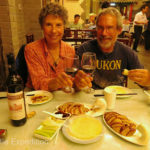
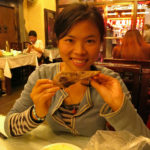
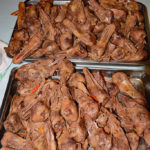






Leave a Comment